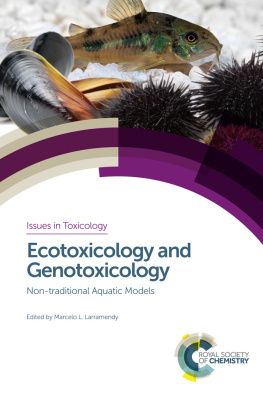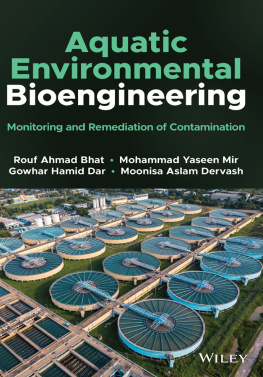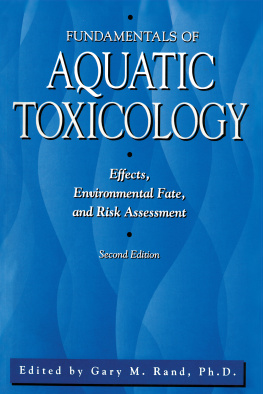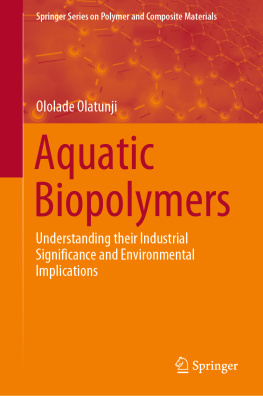Contents
Contents
Marta Martins and Pedro M. Costa
L. A. Maranho, G. V. Aguirre-Martnez and M. L. Martn-Diaz
Roberto Rico-Martnez, Mario A. Arzate-Crdenas, Jess Alvarado-Flores, Ignacio A. Prez-Legaspi and Gustavo E. Santos-Medrano
Sajal Ray, Mitali Ray, Anindya Sundar Bhunia, Pallab Banerjee and Soumalya Mukherjee
Marco Parolini and Andrea Binelli
Rachelle M. Belanger, Sara E. Lahman and Paul A. Moore
Eduardo Madrigal-Bujaidar, Isela lvarez-Gonzlez, Eugenia Lpez-Lpez, Jacinto Elas Sedeo-Daz and Ricardo Arturo Ruiz-Picos
C. R. Walters, V. S. Somerset and E. Pool
C. F. Garca and R. R. Sotelo-Mundo
M. A. A. Pinheiro, C. A. Souza, F. P. Zanotto, R. A. Torres and C. D. S. Pereira
Tolga ava
Adriana Regina Chippari-Gomes, Frederico Augusto Cariello Delunardo, Helen Sadauskas-Henrique, Susana Braz Mota and Vera Maria Fonseca de Almeida-Val
M. M. Santos and N. M. Monteiro
S. Soloneski and M. L. Larramendy
L. Gauthier and F. Mouchet
Norman Wagner and Bruno Viertel
C. S. Prez Coll, C. M. Aronzon and G. V. Svartz
Marcelo L. Larramendy and Sonia Soloneski
M. Camacho, O. P. Luzardo and J. Ors
G. L. Poletta, E. Lpez Gonzlez, P. M. Burella, M. L. Romito, P. A. Siroski and M. D. Mudry
Marcelo L. Larramendy and Guillermo Eli Liwszyc
Preface
Many important ecosystems around the world are being constantly challenged owing to the growing human and industrial pressure exerted upon them. The use of various biomarkers in local, easily available species can be applied to evaluate the response of the biota to such pollutants. Several biological parameters mirror the interactions between toxic agents and biotic matrices. These are powerful tools that can be applied to environmental monitoring tests and studies. Their responses may reveal general deleterious effects to the organism, pinpointing alterations at a cellular, biochemical and molecular level, as well as higher levels of organisation.
Our global society needs to table down actions and set rules to evaluate and considerably reduce the real and potentially hazardous factors in the environment that can, as previously stated, result in health risks for all forms of life (including Homo sapiens sapiens). Despite major positive contributions in the field of health, owing to the immense progress achieved in science, technology and industrialization, the interaction between environmental risk and health is an often intricate equation, not self-evident, that involves a variety of not only social, political and economic, but also lifestyle factors. This cannot be emphasized enough. Health depends on the good quality of environmental basic ingredients, such as air, water, soil and food, among others. We believe that the ultimate challenge in this matter is to weigh-in short-term positive gains, while, at the same time, taking into account long-term effects of substances used. Available information about the toxic effects of heterogeneous xenobiotics, continuously released into human habitats, inadvertently, deliberately, or by non-regulated industrial discharges on biological components of the environment, is inconclusive.
There is not a clear-cut definition of the concept of Environmental Health. Various openings help us in the understanding of this concept. According to the World Health Organization, it is defined by all the physical, chemical and biological factors external to a person and all the related factors impacting upon behaviours. It encompasses the assessment and control of those environmental factors that can potentially affect health. It is targeted towards preventing disease and creating health-supportive environments For the National Environmental Health Association, this concept refers to the protection against environmental factors that may adversely impact human health or the ecological balances essential to long-term human health and environmental quality, whether in the natural or man-made environment. A third definition by the National Institute of Environmental Health Science also involves the criteria that the social environment encompasses lifestyle factors like diet and exercise, socioeconomic status, and other societal influences that may affect health.
In general terms, our health and the health of many other species are negatively affected by five broad categories of environmental hazards, namely, electromagnetic fields (produced by high power lines, electrical wiring, appliances, mobile phones, computers, and TV sets, etc.), radiation (including nuclear fallout from weapons testing, fission materials from nuclear power plants and their respective accidents, leaking radioactive disposal sites, air travel and x-rays), toxic chemicals (some organochlorines, phthalates, polybrominated flame retardants, perfluorinated substances, bisphenol-A) and several toxic metals, among others, which have been shown to have endocrine-disrupting properties, and finally, soil mineral depletion as a complex environmental hazard.
By definition, health risk assessment in its quantitative and/or qualitative determinations includes variants such as the type of risk involved and the severity of response, within or without a probabilistic context. In this regard, risk-based methods of analysis play a strategic role in identifying and ranking adverse responses or the structure of the effects of exposure vis--vis environmental factors.
Many compounds can be hazardous if not used appropriately and may present a real risk to the environment, contaminating soil, water and air. Most of the pollutants in the different environmental compartments exert their effects through cytotoxic, genotoxic and metabolically toxic mechanisms. In pollution studies, there is an increasing interest in biomonitoring markers of biological exposure to pollutants. To achieve this goal, several end-points for the three above-mentioned factors have been used in aquatic and terrestrial invertebrate and vertebrate species on contaminated areas (in situ assays) and to screen for xenobiotics after direct or indirect exposure (in vivo assays).
The use of invertebrate and vertebrate autochthonous species as indicators for monitoring pollutant-induced deleterious environmental effects will raise the current awareness of real and potential hazards. It is also known that most of the environmental pollutants not only affect target organisms, but concomitantly exert negative effects on non-target species as well.
Invertebrate and vertebrate animal models have been used for decades in acute and chronic toxicity tests for hazard identification. They can be very efficient screening systems that have a major role to play in toxicity research, because certain aspects of their biology, physiology and genetic characteristics make them suitable models in ecotoxicological and genotoxicological studies.
These two books intend to provide an overview of the use of non-conventional, locally available, invertebrate and vertebrate species as experimental models for the study of different toxicological aspects induced by environmental pollutants in both aquatic and terrestrial ecosystems. Volume One, Ecotoxicology and Genotoxicology: Non-traditional Aquatic Models includes examples of the use of aquatic species or aquatic stages of terrestrial species and Volume Two, Ecotoxicology and Genotoxicology: Non-traditional Terrestrial Models, is committed to terrestrial non-conventional animal models.
Both volumes aim to shed some light on the matter, whilst offering relevant tools for evaluating risk and to provide a framework for practical discussions. These will foster decisions and actions required to reduce environmental health risk against environmental factors. This piece of work has been systematized for the sake of clarity, presenting some real-life examples and extending concepts (of hazardous factors) to living species that may stimulate new research ideas and trends in the relevant fields.










